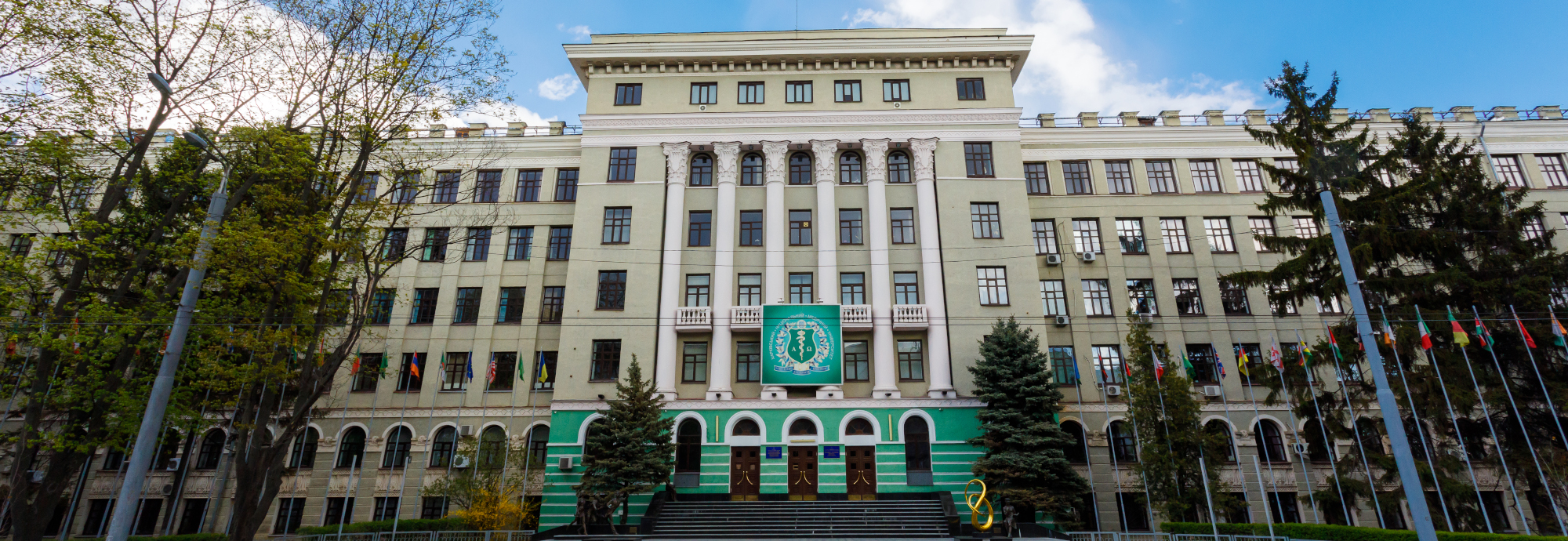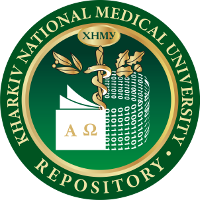ISSN 2310-8363
Репозитарій Харківського національного медичного університету – це відкритий електронний архів академічних текстів, матеріалів наукового та навчально-методичного призначення, створених науковцями, викладачами, іншими працівниками університету та здобувачами
- Положення про Репозитарій Харківського національного медичного університету
- Авторський договір про передачу невиключних прав на використання твору
- Репозитарій ХНМУ: поради автору-депозитору
- Приклади бібліографічного опису документів
З усіх питань щодо Репозитарію ХНМУ звертайтеся до координатора Тетяни Павленко за адресою: repository@knmu.edu.ua

Communities in DSpace
Select a community to browse its collections.
Recent Submissions
Університетська бібліотека як простір психосоціальної підтримки: зарубіжний та вітчизняний досвід
(2025) Киричок, Ірина Василівна; Красюкова, Оксана Олександрівна; Бабак, Тетяна Олександрівна
У роботі розглянуто феномен університетської бібліотеки як простору психосоціальної підтримки в контексті сучасних викликів, зокрема воєнного стану та підвищеного рівня стресу серед студентської молоді. Проаналізовано зарубіжний (США, Великобританія) та вітчизняний досвід упровадження бібліотечних ініціатив, спрямованих на підтримку ментального здоров’я користувачів, та визначено основні форми і практики бібліотечної діяльності, що сприяють психологічному добробуту спільноти. Особливу увагу приділено українським бібліотекам, які в умовах війни виконують важливу місію – формують безпечний, інклюзивний простір для емоційного відновлення, самовираження й соціальної взаємодопомоги. Підкреслено роль бібліотек як партнерів державних програм з охорони ментального здоров’я та складових системи психосоціальної допомоги населенню.
Тhe view of the clinician on the problem of COVID-19
(2021) Yeryomenko, Galyna; Bezditko, T.; Ospanova, T.
The review article features the peculiarities in the epidemiological and clinical picture of a new coronavirus infection, COVID-19. The purpose of the review was to analyze the issues of the management. Pathogenetic relationships between SARS-CoV-2 virus, COVID-19 and angio-tensin-converting enzyme 2 (ACE2) are assessed. Predisposing factors, which result in devel- opment of pneumonia and endothelial dysfunction, disorders in microcirculation, vasocon- striction, work of the renin-angiotensin system with subsequent development of ischemia in certain organs, inflammation and edema of tissues, are analyzed. Lung damage causes devel- opment of interstitial pneumonia, activation of the process of formation of fibrosis and de- creased pulmonary function. Accumulation of anti-inflammatory cytokines, which break the blood-brain barrier, in the CNS can cause dysregulation of central structures, autonomic dys- function and severe asthenic syndrome, which can maintain low-grade inflammation for a long time. Opportune diagnosis and treatment of concomitant diseases in post-COVID-19 patients are of paramount significance for achieving a positive clinical outcome. The plan of rehabilita- tion treatment should be individualized according to the patient’s needs. In order to assess re- mote consequences of COVID-19 all patients require further follow-ups.
Keywords: SARS-CoV-2, post COVID-19, ACE2, cytokines.
Effect of 3,3ʹ-diindolylmethane in different solvents on Pseudomonas aeruginosa biofilm
(2025) Malanchuk, Svitlana; Mishyna, Maryna; Kot, Yurii; Dzhoraieva, Svitlana; Mozgova, Yuliya; Malanchuk, В.; Mishyn, Yurii
Today, the most common pathogens causing nosocomial infections are Gram-negative bacteria, especially Pseudomonas aeruginosa. One of the leading factors in determining the resistance of bacteria is their ability to form biofi lms.One promising class of agents capable of aff ecting biofi lms is indoles (diindolylmethane).
Th e aim of this work was to determine the eff ect of diindolylmethane in diff erent solvents on the formation of P. aeruginosa biofi lm.
Methods. For microbiologic examination, biological material was collected from purulent-infl ammatory complicated gunshot and shrapnel wounds. Th e antimicrobial activity of samples containing 0.5% solution of 3,3’-diindolylmethane derivatives (Ts-D5-1 – sample 1, Ts-D8-1 – 2, VE-D67-1 –3, VE-D68-1–4, VE-D71-1–5, W-014-1–6, W-015-1–7, and W-016-1–8 in dimethylsulfoxide solvent and Ts-D5-2 – 9, Ts-D8-2 – 10, VE-D67-2 – 11, VE-D68-2 –12, VE-D71- 2 – 13, W-014-2 – 14, W-015-2 – 15,and W-016-2 – 16 in N-methylpyrrolidone solvent) was determined. Th e study was carried out by the method of diff usion in agar. Th e biofi lm formation study was performed according to the method of O’Toole.
Results. Samples 14, 15, and 16 showed a high antimicrobial activity, among which sample 14 was the most effi cient: the diameter of the lysis zone was 10 mm aft er 24 hours, 11 mm aft er 48 hours, and 12 mm aft er 72 hours. It was demonstrated that all other samples had less marked antibacterial activity, which was slightly potentiated over time.
Conclusions. Sample 14 showed the highest antimicrobial activity. Moreover, the eff ect of potentiation of the antimicrobial activity of the solution was observed. Th e test solution prevented the formation of a biofi lm when it was applied to the well surface, and also led to the destruction of the already formed daily biofi lm of P. aeruginosa.
Біогенні елементи: медико-хімічний аспект
(ХНМУ, 2025) Сирова, Г.О.; Козуб, С.М.; Чаленко, Н.М.
Практична підготовка лікарів-інтернів на базах стажування. Частина ІІІ. Абдомінальна хірургія
(2025-04-24) Бойко, Валерій Володимирович; Мінухін, Дмитро Валерійович; Євтушенко, Денис Олександрович; Лавриненко, Артем Сергійович; Іванова, Юлія Вікторівна; Доценко, Дмитро Григорович; Битяк, Сергій Юрійович
Перелік практичних навичок/компетентностей, що повинні набуватися лікарями-інтернами хірургами на базах стажування, згруповані згідно з програмою підготовки в інтернатурі за спеціальністю: "Хірургія", розробленої групою експертів МОЗ із деяких питань проходження інтернатури за спеціальністю "Хірургія", склад якої затверджено наказом МОЗ України від 01.11.2021 № 2390, та рецензованої групою експертів МОЗ України за напрямами, склад якої затверджено наказом МОЗ України від 28.10.2020 № 2455.
Програма підготовки в інтернатурі з хірургії – єдиний комплекс освітніх та практичних компонентів, спланованих і організованих закладами вищої освіти і базами стажування з метою забезпечення набуття лікарями-інтернами компетентностей, необхідних для отримання кваліфікації лікаря-спеціаліста, їх професійної готовності до самостійної діяльності за фахом.
Програма базується на сучасних наукових результатах і засадах доказової медицини у сфері хірургії. Програма забезпечує набуття та вдосконалення високого рівня знань і професійних навичок із питань діагностики та лікування основних хірургічних захворювань, оволодіння і засвоєння основних хірургічних навичок та етапів операційних втручань.
Програма підготовки в інтернатурі з хірургії триває 3 роки та складається з двох частин: освітньої та практичної. Підготовка лікарів-інтернів проводиться за індивідуальними навчальними планами, розробленими на підставі програми підготовки в інтернатурі, та навчальних планів, затверджених вченою радою ХНМУ. За період підготовки в інтернатурі лікарі-інтерни повинні оволодіти компетенціями, знаннями та навичками, які визначені індивідуальним навчальним планом та програмою підготовки в інтернатурі
